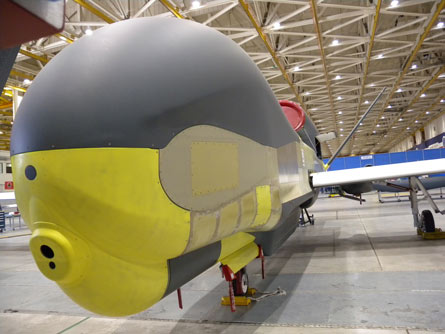While the overall RQ-4 Global Hawk programme moves along, the Pentagon has repeatedly voiced its displeasure over the unmanned air vehicle's cost and the pace of production in recent months. Northrop Grumman countered first on the defensive, and later, at the Farnborough air show in July, went on the offensive with accusations of its own for the US Department of Defense
In June, the Pentagon's top weapons buyer, Ashton Carter, and US Air Force assistant secretary for acquisition David Van Buren separately told reporters they were disappointed with the cost of the air vehicle and that testing has been slower than expected.
 |
|---|
© Gayle Putrich/FlightglobalGlobal Hawk has put the Pentagon's nose out of joint |
"I am not happy with the pace of that programme and we are not happy with the cost of the air vehicle," Van Buren said.
In a rare, on-the-record roundtable with reporters, Van Buren gave a laundry list of reasons why he - and the air service - is dismayed with nearly every aspect of the programme: the high cost, the lengthy testing and delivery period, the programme's pace, the sensors on the aircraft and even the aircraft itself. Testing and delivery of the Block 30 aircraft in particular was slower than expected, he said.
Northrop quickly countered, arguing that the USAF is well aware of overall cost reductions on Global Hawk's Block 20, 30 and 40 systems and associated payloads. "While there have been cost spikes within production lots due to the quantity procured within each lot, overall cost of the air vehicle and the sensors is trending down, as the company predicted and expected," the company says.
"Additional cost reductions have been identified by the company and will be evaluated for suitability."
Weeks later, at Farnborough, Northrop executives took another swipe at the Pentagon's complaints, calling the accusations that the Global Hawk is expensive and unreliable "exaggerated" and that the real problems with the programme lie in "issues with controlling requirements" and overuse of the platform.
"Global Hawk suffers from a lot of masters," says Ed Walby, Northrop director of business development for the high-altitude UAV. "There are issues with controlling requirements and a lot of evolving requirements. Trying to capture all of those to satisfy all the customers becomes quite difficult."
High demand has increased some costs, he says. Combatant commanders have asked to fly the Global Hawk far more than contracted. "In one case, six times its required operational capacity," he says.
Flying so much more than originally anticipated means more spare parts are required to keep the aircraft running and more operations and maintenance funds are spent.
The UAV is reducing in cost and is very reliable, Walby says. In 2009, only two sorties were cancelled because of maintenance, he says, out of more than 250 scheduled missions.
At the same time, the US military buys the RQ-4 at the fairly low rate of about four a year. Northrop could build up to 12 a year, Walby says, and at a lower cost. "I like to say it's basically 'buy 10, get one free'," he quips.
Meanwhile, air force and navy leaders have been working to increase the commonality between the Global Hawk fleet and the Broad Area Maritime Surveillance (BAMS) programme. The focus has been on sharing systems and components in the ground systems for both fleets, as well as working out production efficiency with Northrop.
Just before leaving town for summer holidays, the House Armed Services Committee seemed to side with Northrop in the debate, denying a Pentagon reprogramming request to move $71 million from the RQ-4 Global Hawk programme to spend elsewhere.
The committee noted that the "programme has been consistently underfunded in the area of spare parts", in a 30 July letter from panel chairman Republican Ike Skelton, to DoD comptroller Robert Hale. "The committee encourages the air force to obligate these funds as soon as possible in order to support ongoing operations."
Source: Flight International























